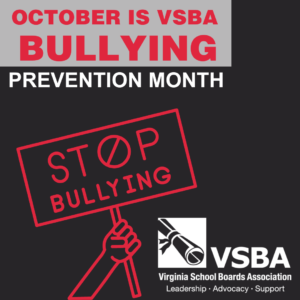October is VSBA Bullying Prevention Month
In an effort to promote awareness of school bullying, the VSBA Board of Directors has designated the month of October as VSBA Bullying Prevention Month. Childhood bullying is a significant problem nationwide. It can cause school absenteeism, mental and physical stress, poor school performance, poor self-esteem, and in some cases, school violence. Students who experience bullying are at increased risk for depression, anxiety, sleep difficulties, lower academic achievement, and dropping out of school. Bullying can also happen online. Reports of cyberbullying among public school attending students are highest for middle school (33%), followed by high school (30%), combined schools (20%) and primary schools (5%). School board members, superintendents, teachers, and parents play a critical role in creating a climate where bullying is not tolerated. It has been proven when adults and children stand together, bullying ends.
VSBA President David Woodard has provided a PSA to encourage participation in VSBA Bullying Prevention Month:
The Bullying Prevention Month toolkit is available here.
Additional Resources
Bullying
- StopBullying.gov: This interagency website provides information and resources on bullying, cyberbullying, prevention, and response.
- Preventing Bullying: This webpage provides background information on bullying, including bullying statistics in the United States, as well as prevention strategies to stop bullying before it starts.
- KnowBullying Mobile App: Through this app, parents, caregivers, and educators can find information to start conversations with children, share successful bullying prevention strategies, recognize the signs of bullying, and support children who are being bullied.
- The Relationship Between Bullying and Suicide: What We Know and What It Means for Schools: This resource provides school administrators, teachers, and other school staff with concrete, action-oriented information based on the latest science to help improve schools’ understanding of and ability to prevent and respond to bullying.
- Measuring Bullying Victimization, Perpetration, and Bystander Experiences: A Compendium of Assessment Tools: This collection provides the school community with tools to measure a range of bullying experiences, including assessing self-reported incidents and the prevalence of bullying.
Cyberbullying
- Dealing with Cyberbullies: These tips and recommendations outline what cyberbullying is, why it has become a problem, and how to protect students.
- Tips for Teachers: This webpage provides information for teachers, school personnel, and staff to identify warning signs a child is being cyberbullied or is cyberbullying, as well as strategies to prevent and address it.
School Bus Bullying
- Bullies on the Bus: This webpage provides tips for how how parents, kids, bus drivers, and schools can work together to make the school bus bully-proof.
Social and Emotional Learning, School Climate, and Mental Health
- National Technical Assistance Center on Positive Behavioral Interventions and Supports: This program supports schools, districts, and states to build a framework to improve outcomes for students with, or at-risk for, disabilities, enhance school climate and school safety, and improve conditions for learning to promote the well-being of all students.
- School Climate Improvement Resource Package: This set of resources, reference manuals, and action guides outlines ways school leaders, personnel, and community partners can improve school climate and create an environment where students feel safe, supported, and accepted.
- Mental Health and School Safety: This topic page on SchoolSafety.gov features resources, best practices, and strategies to support the implementation of mental health support and access initiatives at your school.

